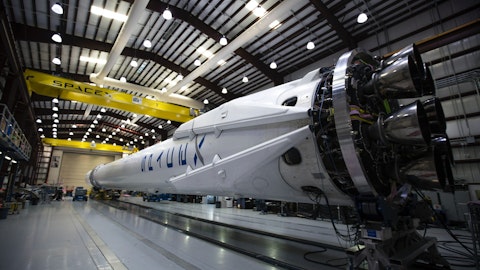Dave Burney: Yes, the way we’re forecasting in particular with regard to the spot buys, which, as I pointed out, are not insignificant on a quarterly basis is to €“ they will gradually phase €“ we’re expecting them to phase out as there is more normalization in the supply chain. We don’t expect this to happen until we move into the second half of the year. So that by the fourth quarter we’re expecting it €“ the spot buy cost to decrease. The other thing that we’re expecting to see as we mentioned earlier as we roll into new contracts where our quotes have reflected higher costs and a higher selling price, those will start to become more meaningful as we move through the year and into next year as well. The 40% contribution margin I think the way we’re forecasting is expecting that to gradually improve as we move through the year as well.
Jon Tanwanteng: Great. And then last one from me, did you say that your cash tax burden would be $67 million this year, or was that a non-cash number?
Dave Burney: I €“ what I intended to say was $6 million to $7 million.
Jon Tanwanteng: Well, $6 million to $7 million. Okay. Understood that caught me off guard. I apologize.
Dave Burney: Oh, did you hear 60?
Jon Tanwanteng: I heard 67 and maybe that was just my fault.
Dave Burney: No, no, no, $6 million to $7 million. Yes.
Jon Tanwanteng: Understood. Thank you. Okay, I’ll jump back in queue. Thanks a lot, guys.
Operator: And our next question comes from the line of Michael Ciarmoli with Truist Securities. Please proceed with question.
Michael Ciarmoli: Hi, good evening guys. Thanks for taking the questions.
Pete Gundermann: Hello.
Michael Ciarmoli: Maybe €“ how are you? Peter or Dave, just to stay on that margin, kind of the contribution margin and just thinking about aerospace margins, I mean, given the volumes you put up, I think it was what, three eight in the quarter. Should we expect a kind of steady increase in those aerospace margins as we move through the year and presumably, knock on wood, nothing kind of gets derailed here with supply chain, but we continue to see the demand flow through. Is that a reasonable expectation that the margins build off this level?
Dave Burney: Yes, I think €“ when I speak to that 40%, I’m speaking to the incremental contribution margin. But what will happen also as the top line grows is better absorption of the fixed costs. So yes, we would expect as aerospace continues to have top line growth that we will see those margins continue to improve.
Michael Ciarmoli: Okay. And then, I mean, Pete, you talked a little bit about pricing. I mean, would you be able to kind of elaborate or kind of give us more detail in terms what you think or what you are trying to push through for price increases and what that’s kind of adding to the equation this year?
Pete Gundermann: It’s a little hard to quantify. I guess I would say that for the most part, I think, we’re in pretty good shape, in part because we’ve had a lot of heavy demand, heavy bookings recently and quite a bit of our revenue base turns over on a pretty frequent basis. We certainly have long-term contracts on major programs and in some of those cases, we’re able to increase prices. In some cases we got to wait for the contract to renew. But I guess I feel that assuming that inflation doesn’t pop along at ridiculously high rates for another two or three years, I think, we’re going to ride it out and I think it will adjust in due course. I’m not considering at this point a major issue, and that’s not to say we don’t have our stress points.





